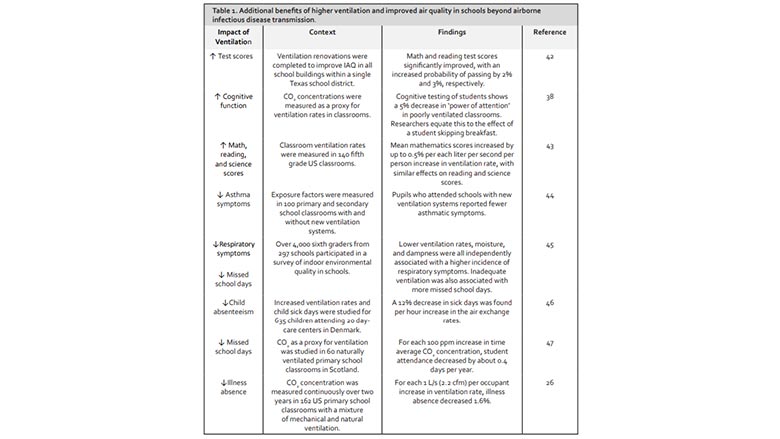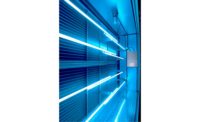Following the COVID-19 pandemic outbreak, U.S. legislators allocated more than $200 billion to school districts to improve safety and student achievement. The Elementary and Secondary School Emergency Relief (ESSER) legislation specifically permits using these funds for the “testing, repairing and upgrading projects to improve air quality in school buildings.”
Therefore, school systems have an unprecedented opportunity to upgrade HVAC systems and physical plants that could transform the quality of air students and teachers breathe for decades.
School IAQ fundamentals
Public health officials and professional building engineers know the fundamentals for improving indoor air quality in schools —ventilation or dilution, mechanical filtration and germicidal UV-C energy.
To support school administrators, the U.S. Centers for Disease Prevention and Control (CDC) issued guidance for proper Ventilation in Buildings:
- Consider using ultraviolet germicidal irradiation (UVGI) as a supplemental treatment to inactivate SARS-CoV-2, especially if options for increasing room ventilation and filtration are limited; and
- Upper-room UVGI can be used to provide air cleaning within occupied spaces, and in-duct UVGI systems can help enhance air cleaning inside central ventilation systems
These engineering controls that improve air quality are cited by the CDC and recommended by the American Society of Heating, Refrigerating and Air Conditioning Engineers (ASHRAE) as part of its Position on Infectious Aerosols:
"Engineering controls demonstrated to reduce the risk of exposure to infectious aerosols include dilution with outdoor air provided by mechanical or natural ventilation, filtration of indoor air, indoor airflow patterns, and disinfection by germicidal ultraviolet light and other technologies proven to be effective and safe.”
 The study also found that nearly one in 13 children in the U.S. has asthma, which is triggered by indoor allergens commonly found in schools and is the leading cause of absenteeism due to chronic illness.
The study also found that nearly one in 13 children in the U.S. has asthma, which is triggered by indoor allergens commonly found in schools and is the leading cause of absenteeism due to chronic illness.
Germicidal UV-C originally tested in schools
Among ASHRAE's public health recommendations is ultraviolet energy (UV-C), used for nearly a century to disinfect room air simply, safely and quickly without adding chemicals or other byproducts to the environment.
Through a process known as photodimerization, UV-C energy causes genetic damage that prevents airborne and surface-bound viruses, bacteria and fungi from infecting and replicating, ultimately leading to cell inactivation.
Ironically, UV‑C technology was proven to inactive airborne pathogens in school classrooms nearly eight decades ago. In 1937, epidemiologist William F. Wells installed upper-room germicidal UV lamps in suburban Philadelphia day schools to combat the measles virus.
He then compared the measles infection rates of students who attended schools without UV-C. Schools with air-sanitizing equipment experienced a 13.3% infection rate compared to 53.6% for the control group. That’s a four-fold decrease in infection rates for schools equipped with germicidal UV-C.
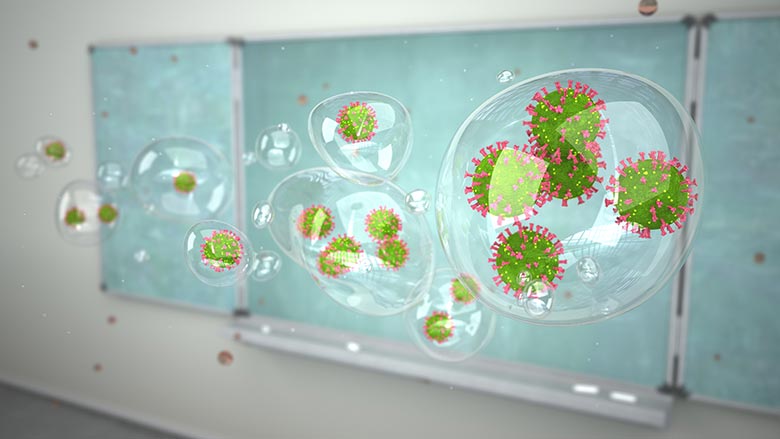 The public health agency notes that UV‑C kills airborne pathogens at their source (as contaminants are spread in room air), and fixtures are installed to prevent direct UV exposure to people in the room.
The public health agency notes that UV‑C kills airborne pathogens at their source (as contaminants are spread in room air), and fixtures are installed to prevent direct UV exposure to people in the room.
While Upper-Room UV‑C fixtures are not standard in classrooms, the CDC notes that boosting room ventilation rates can reduce the number of infectious viral particles. “Ventilation interventions include opening windows, using fans, adding high-efficiency particulate air (HEPA) fan/filter systems, and adding Upper-Room UV‑C.”
The public health agency notes that UV‑C kills airborne pathogens at their source (as contaminants are spread in room air), and fixtures are installed to prevent direct UV exposure to people in the room. Therefore, the CDC recommends UV-C for indoor spaces with insufficient or no mechanical HVAC systems or spaces where adequate natural ventilation cannot be maintained year-round.
If adequate building ventilation and airflow mixing levels are not appropriate, concentrations of pathogens will multiply, raising the risk of infection for room occupants and viral spread. Even with proper ventilation, the possibility exists that HVAC systems can spread airborne pathogens beyond the source classroom.
Student health/performance outcomes driven by improved IAQ
To help put school air quality in perspective, 87 of 100 classrooms had ventilation rates below recommended minimum standards, according to a study from the LANCET COVID-19 Commission, suggesting that nearly nine of every 10 classrooms lack sufficient healthy air.
Moreover, researchers found that better ventilation and air quality influence student health and stronger academic performance.
“In addition to decreased airborne infectious disease transmission, research shows that ventilation and air cleaning improvements are likely to lead to improved academic performance (in particular reading and math performance), fewer missed school days for students, higher scores on cognitive function tests, and many benefits for teachers including decreased respiratory symptoms, increased teacher retention, and improved morale.”
How can UV-C be applied to improve school IAQ:
There are three primary means of applying UV‑C for air and HVAC protection against infectious agents: Upper-room or upper air, HVAC airstream disinfection and HVAC coil/surface disinfection.
1. Upper-Room/Air systems. Wall-mounted, upper-room UV C fixtures generate a germicidal zone near a room’s ceiling where infectious pathogens are quickly neutralized. In addition, the natural rise-and-fall of convection or mechanical air currents lift pathogens overhead, where they are inactivated in a matter of seconds. (See Figure 1).
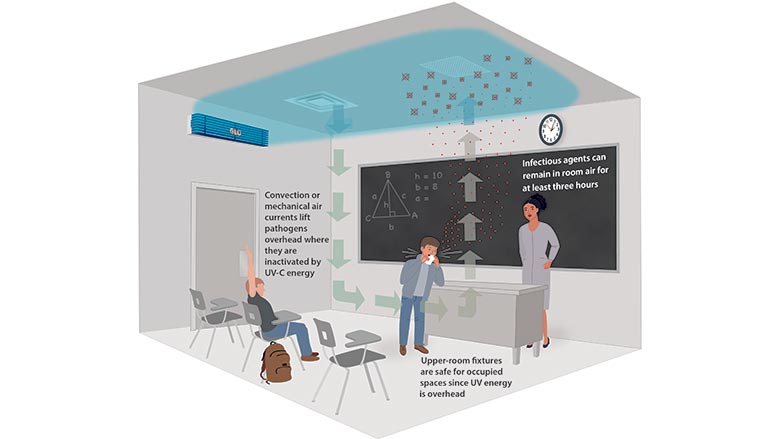 Upper-Room germicidal fixtures are wall-mounted and use baffles to direct the UV C energy upward and outward, ensuring that no UV C energy enters the occupied portion of the room. Image courtesy of UV Resources.
Upper-Room germicidal fixtures are wall-mounted and use baffles to direct the UV C energy upward and outward, ensuring that no UV C energy enters the occupied portion of the room. Image courtesy of UV Resources.
Upper-room UV‑C fixtures can provide a space with additional air changes per hour (ACH), which helps to augment other building ventilation and dilution strategies. And since UV‑C energy is overhead, upper‑room fixtures are safe for occupants. (See Figure 2).
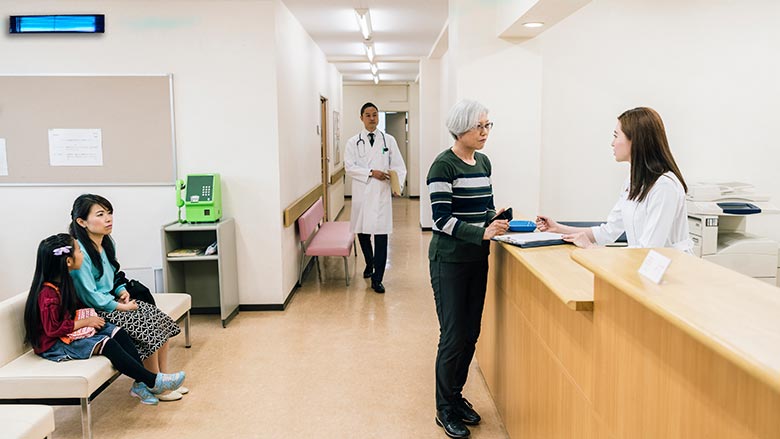 Upper-Room UV fixtures mounted overhead near a room's ceiling direct germicidal energy upward so that room occupants are safe to go about their everyday business. Image courtesy of UV Resources.
Upper-Room UV fixtures mounted overhead near a room's ceiling direct germicidal energy upward so that room occupants are safe to go about their everyday business. Image courtesy of UV Resources.
2. HVAC airstream disinfection systems. As seen in Figure 3, UV C airstream or in-duct disinfection fixtures are installed in air handling unit plenums or HVAC ductwork to inactivate microorganisms “on-the-fly.” A UV C in-duct system can inactivate a microbe in a fraction of a second and can reduce pathogen concentrations on each HVAC cycle or pass. An airstream disinfection system can disinfect a room’s total air volume multiple times each hour.
HVAC airstream UV C systems should be properly designed to maximize UV C exposure or “residence” time with the pathogen for the photodimerization process to occur. The faster the air is moving (less residence time), the more UV C energy will be necessary to achieve the required dosage.
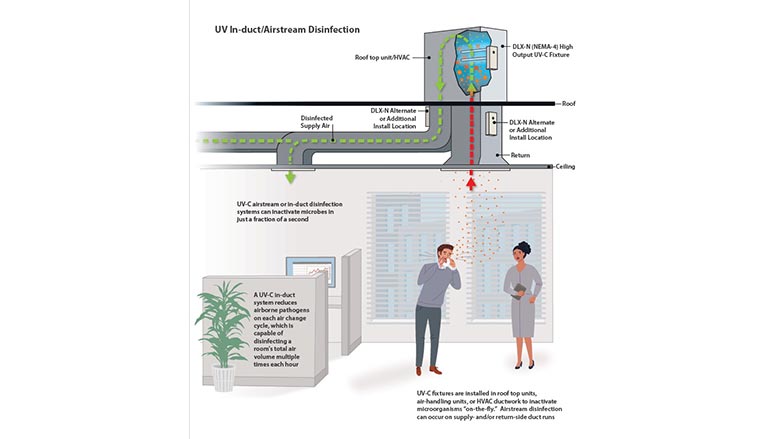 In-duct germicidal UV C systems are installed in air-handling units or air distribution ducts to inactivate microorganisms and disinfect moving airstreams “on-the-fly”— as well as on HVAC surfaces. Image courtesy of UV Resources.
In-duct germicidal UV C systems are installed in air-handling units or air distribution ducts to inactivate microorganisms and disinfect moving airstreams “on-the-fly”— as well as on HVAC surfaces. Image courtesy of UV Resources.
3. Coil/surface-disinfection systems are primarily installed within HVAC air-handling units to destroy biofilm, bacteria and mold that settle and proliferate on HVAC coils, air filters, ducts and drain pans. See Figure 4. UV C prevents these areas from becoming microbial reservoirs for pathogen growth that can eventually be circulated by HVAC systems. While not specifically designed for airstream disinfection, an HVAC surface irradiation system can also provide first-pass inactivation ratios of airborne pathogens of 30 percent or more, along with the primary benefits of restored cleanliness, improved heat-exchange efficiency, and lower energy use.
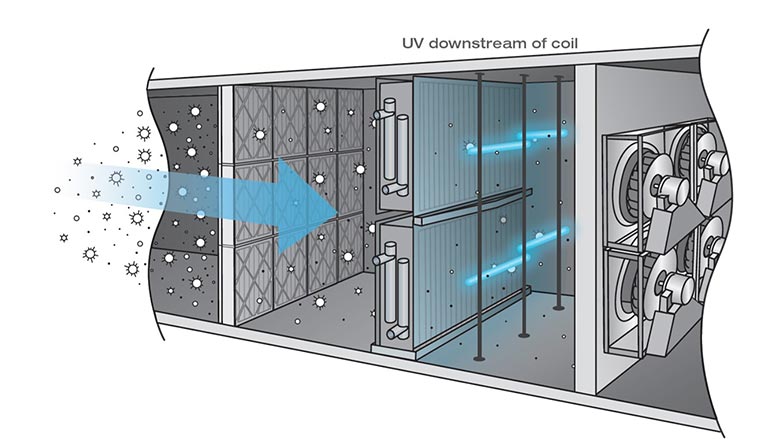 The application of UV-C energy prevents the formation of mold and biofilm on HVAC coil fin and tube surfaces and helps maintain original heat-transfer efficiency rates. Image courtesy of UV Resources.
The application of UV-C energy prevents the formation of mold and biofilm on HVAC coil fin and tube surfaces and helps maintain original heat-transfer efficiency rates. Image courtesy of UV Resources.
Studies find improved ventilation lead to improved student performance
A recent study from the LANCET COVID-19 Commission, “Designing infectious disease resilience into school buildings through improvements to ventilation and air,” identified some fascinating student health/performance outcomes that can result from better ventilation and improved indoor air quality. These are some of the key findings.
EXISTING SCHOOL AIR QUALITY
“It is imperative that pandemic relief for schools be applied to enhancements that are evidence-based, provide long-term value, and do not create additional pollutants that may be harmful to the health of students, teachers, and staff;”
“In a study of 100 U.S. classrooms, 87 had ventilation rates below recommended minimum standards;” and
“Nearly one in 13 children in the U.S. has asthma, which is triggered by indoor allergens commonly found in schools and is the leading cause of school absenteeism due to chronic illness.”
ACADEMIC PERFORMANCE LINKED TO IAQ
“In addition to decreased airborne infectious disease transmission, research shows that ventilation and air cleaning improvements are likely to lead to improved academic performance (in particular reading and math performance), fewer missed school days for students, higher scores on cognitive function tests and many benefits for teachers including decreased respiratory symptoms, increased teacher retention, and improved morale;” and
Other researchers have linked improved ventilation to better classroom attendance and student health. They propose that ventilation rates in elementary school classrooms not only meet but substantially exceed current ventilation guidelines.
VALUE OF VENTILATION
“If improved ventilation and air cleaning through filtration is not possible, then other science-based technologies should be considered, such as in-duct germicidal UV lights or upper-room germicidal UV. UV technology has been well studied and utilized for decades to control the transmission of airborne infectious diseases, and the Centers for Disease Control and Prevention (CDC) have provided guidelines for the effective design and operation of such systems. This approach can be particularly cost-effective in larger spaces, or spaces that are not ventilated;” and
“Inadequate outdoor air ventilation has been explicitly implicated in several large COVID-19 outbreaks across various indoor environments.”
